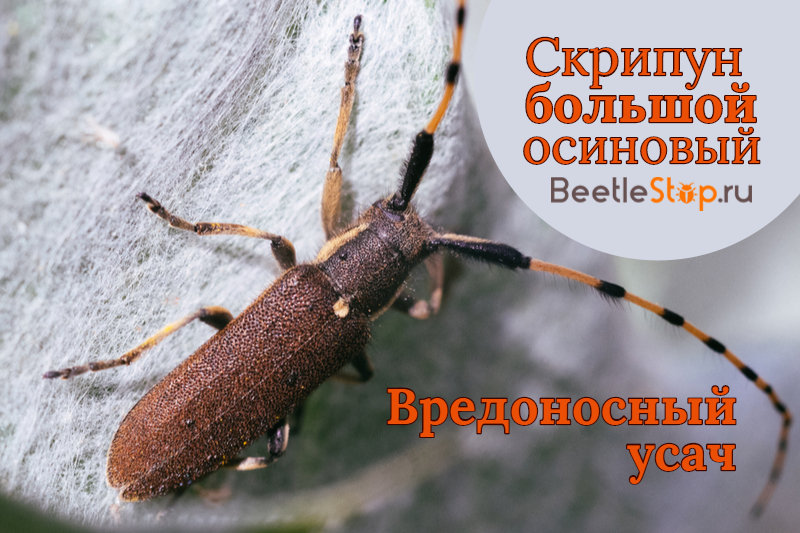Large aspen fiddler - lumberjack damaging poplar
Most species from the family of barbel or lumberjacks live and feed on trees and bushes. Adult beetles feed on leaves or pollen, and larvae feed on wood. In the west of Europe and in Siberia there lives a large aspen violinist, damaging poplar, aspen, willow. Mass distribution of insects leads to drying out and death of plantings. Beetles often inhabit trees together with biologically related species: small aspen creak and willow creak.

View description
The large aspen fiddler (Saperdacarcharis) is a typical representative of the barbel family, the genus of the crest. The length of the beetle is 20-28 mm. The color is black, the body is covered with dense hairs of brown-yellow or gray-yellow color. The cover resembles felt with black dots. The head is sheer, the mandibles are well developed. Large faceted eyes are located on the sides of the head at the base of the antennae. Antennas are simple, 11-segmented. By the end, the antennae become thinner, their segments are covered with gray and black hairs.
Interesting fact. The beetles got the name of the genus “creaks” for their ability to make creaky sounds using a shaving machine.
Pronotum transverse, scutellum with granular surface. Elytra elongated, convex. Punctation of anterior part coarse, softened to posterior margin. The last third of the elytra is lighter than the rest. The wings are well developed, bugs fly between trees. Three pairs of limbs have different lengths - the front is the shortest, the rear is the longest. The lower part of the body is covered with raised hairs. On the extremities, gray hair.
Sex differences are manifested in the structure of the genital organs and secondary signs:
- antennae of males reach the end of the body, and in females shorter;
- elytra of females parallel, gradually rounded at the end, in males at the apex strongly narrowed.
Distribution area
The species is a large aspen violin found in Western Europe, Mongolia, Western Asia, Afghanistan, North Africa, and Ukraine. Insects harm trees in Korea, in the north of China. In Russia, lives in the European part, Siberia, the Far East and the Caucasus.
Lifestyle & Reproduction
The beetle years begin with the onset of warm weather, in the south in June-July, in the north in August. Individual individuals are found in September. Adults are active in the evening and at dusk. They need extra nutrition on the leaves. Beetles prefer hardwood - aspen, poplar, rarely willow.
Adults keep in the crowns of trees. After mating, females lay eggs at the base of the trunk. In the butt part, incisions are made in the cortex, one egg is placed in the recess. Fertility of the female is 50-60 pieces. The period of embryonic development depends on climatic conditions. In some regions, it is 8-11 days, while in others, the eggs hibernate, remaining in the diapause. The violinist has a lifespan of about two months.
Larval development
The body of the larva is fleshy, white, and vermiform. Covered with short setae. Pronotum and head brown. The head is pulled into the prothorax and covered with a chitin capsule. Antennae short, composed of two segments, bent down. Near them there is a pair of simple peepholes.Mandibles are long, smooth, with a straight cutting edge. The larva is legless; special calluses on the back are used for movement. The adult larva grows to 35-45 mm.
Information. Large aspen violinist is listed in the Red Book of the Voronezh region as a rare species.
Larva of the first age gnaws moves in sapwood. By winter, it penetrates the wood, where it falls into diapause until spring. Larvae waking up or hatching from wintering eggs gnaw out a vertical course directed upwards. On young trees, its length is 30-50 cm, and on adults - 100-150 cm. Drilling flour and shavings are poured out of the holes in the feeding places of the offspring of barbel and the waste accumulates in the basal part. Larvae hibernate twice; during their development, they pass four ages and shed three times.
In the spring of the third year, the larva prepares for pupation. She stops eating, creates a pillow of fiber shavings at the end of the vertical stroke. Pupa free, yellow-white. The head is bent, the antennae is pressed to the sides. Length 45-47 mm. The pupal phase lasts 2 weeks. The imago through the flight hole gets out.
Maliciousness and control methods
In the process of feeding, imagoes gnaw holes in the leaves of trees. The sheet plate is seriously damaged, holes with torn edges occupy a large area. In addition, the bark in the form of a ring is gnawed on the shoots and young branches. From damage, the branches grow more slowly, deform, and sometimes die due to impaired movement of nutrient juices. Through gnawing bark, trees become infected with fungal infections - red or black cancer.
Information. A large aspen violinist populates young healthy trees growing on the fringes and woodlands.
The main harm to the plants is caused by larvae. Parts of wood damaged by insects lose their economic value. Due to damage to the woods, core rot appears in the strokes. Young plantings die or significantly deform, losing their decorative and technical qualities.
Ways to fight
In places with a probability of infection, reconnaissance and detailed monitoring of the status of poplars and aspen is carried out. Signs of pests are:
- inflows at the bottom of the trunk;
- the appearance in the butt zone of holes from which drill flour is poured;
- drying tops.
To prevent the death and damage of trees will help compliance with sanitary rules:
- Timely felling of freshly populated trees.
- Clean the cutting areas, immediately remove the ham.
- The lower part of the trunks of poplars and aspen is treated with insecticides.
- Systematically sample dry wood.
Attraction of insectivorous birds helps to limit the number of pests.

